Sewing with Fleece... The Stretch Test
2018 Feb 19th
The other day, I spent some time introducing you to some different types of fleece, and how to tell apart some of the variations that stores might sell under the Fleece category. I was surprised to learn there are so many different types of fabric under this title, and it lead me to really want to make sure that there is a clear way to tell whether or not a specific fabric is suitable to use with certain patterns.
Before we get to that though, I definitely recommend having a look at the previous post in this series...
Sewing with Fleece... What is Fleece?
Today, I'm going to show you how to do a Stretch Test using several different types of fleece (and fleece-like fabrics) that were talked about in the first part of this Series.
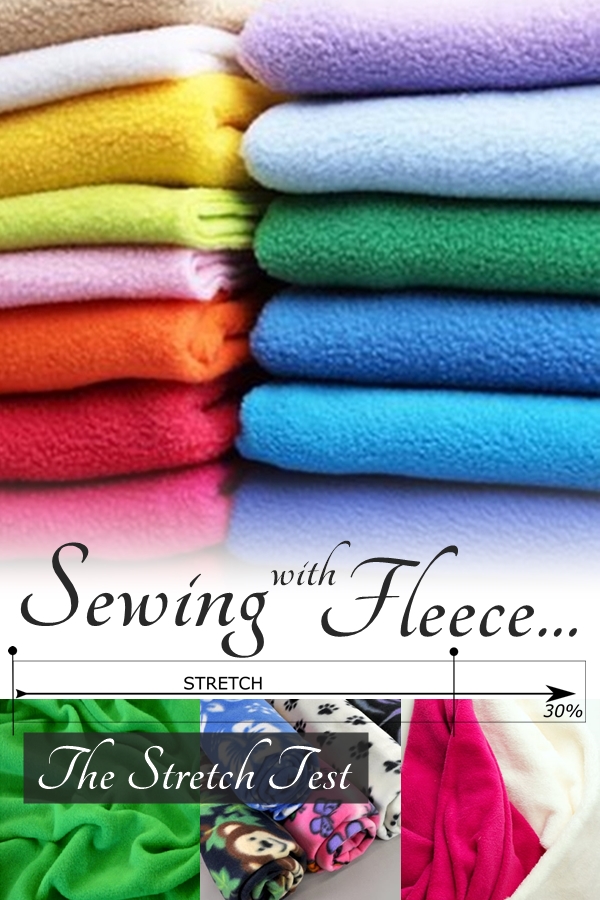
What is a Stretch Test?
Patterns that are designed for knit fabric should state clearly somewhere in the pattern what "percentage of stretch" is required for all or some of the parts. So how do you know if your chosen fabric has enough stretch to be suitable for the pattern you would like to use it for? You test it. Testing for how much stretch a particular fabric has is not difficult, nor does it require any fancy equipment.
You will need:
- 2 straight pins
- fabric being tested
- a ruler or Stretch Guide
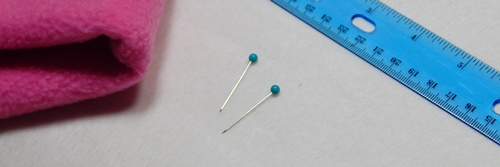

Shown here is a Stretch Guide that I made for testing fleece. It shows two markers, at a distance of 5 inches apart. The end of the guide measures an additional 30%.
(The 5" distance is just a simple number to calculate with that also fits easily on a sheet of paper; but you can use any number as long as you know how to calculate percentages. If you are working without a guide, simply choose a number on a ruler that is easily divided into tenths... 20 cm for example would have 30% stretch at 16 cm. If you are working in inches, you could use 10 inches instead).
I've included a copy of this Stretch Guide for you to download below.
In my fleece patterns, the minimum amount of stretch that is needed is 30%. Because this is a minimum, if your fabric has more stretch, that is also good. The less stretch it has, the more likely you will end up having difficulty with the fit or with getting it on and off. If the fabric has less than 30% stretch, it may in fact be impossible to wear in the selected size. Since this series is all about fleece, I will use 30% as the required percentage of stretch in this example.
If you are working with a pattern that calls for a higher percentage of stretch, the test is done the same way, just the numbers will be different (a pattern requiring 50% stretch, for example, would need to stretch from 5 inches to 7.5 inches). This is especially handy to know how to calculate if you are at the fabric store and don't have a Stretch Guide with you.
I'll show you how it works...
The first thing you need to figure out is which direction has the most stretch. Most of the time, this will be the crosswise grain (perpendicular to the selvage).
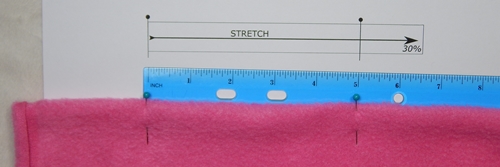
With pins, mark a distance 5" apart. This is the same distance apart as the two pin markers on my Stretch Guide. Near to a cut edge or next to the selvage, the fabric may stretch differently, so will be more accurate to place the pins a couple inches away from any edge.
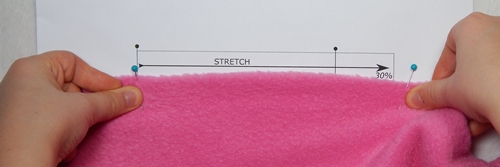
Holding one pin securely at "0" or at the left side of the Stretch Guide, GENTLY stretch the fabric by holding and sliding over the other pin. DO NOT force the fabric... you are wanting to test the natural stretch, so as soon as you feel that is resisting or wanting to pull back, you are probably over-stretching it.
If the fabric comfortably stretches to the 30% mark or beyond, it is a suitable fleece (or other type of fabric) for the project you have in mind. In this example, if you didn't have the guide with you and are using a ruler instead, 5 inches would stretch to 6.5 inches at 30%.
And a big Thank You to my son for his help with getting these photos. I couldn't hold the camera and do the stretch test at the same time, so he offered to give me a hand (actually, make that two hands). Thanks, buddy!
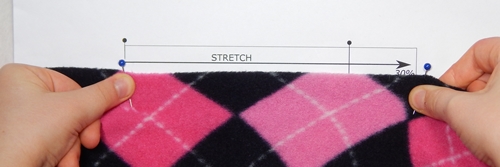
Shown above is a very common medium-weight variety of polyester fleece. This particular weight/type does have the required minimum 30% stretch.
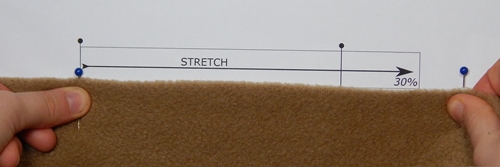
Lambskin Fleece - this is a variation on the same basic type of fleece as the first one, but as you can see, it has even more stretch.
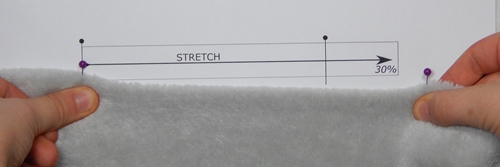
Cuddle/Plush - while not immediately what I think of as fleece, this type is also quite stretchy and would work well for most fleece patterns (though it is slippery and more care needs to be taken with the raw edges). Not all types of cuddle/plush will have this much stretch; the more dense it is, the less stretch it will have.
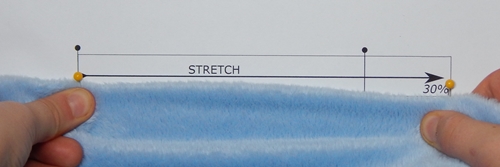
Minky - As you can see with this fabric, there is less natural stretch here. It just barely reaches the 30% mark. Personally, I would probably size up if using Minky, just to give it more wear time before my child outgrows it. I would also hesitate to use Minky for areas that need extra stretch, such as collars. It will work... but it won't give you any extra give.

Sweater Fleece/Sweater Knit - This is fabric that looks like a traditional knit sweater on one side, but has the brushed look of fleece on the other side. Depending on how tightly knit the sweater side is, it may or may not have enough stretch to work with a fleece pattern. This particular kind has plenty, and would be a good choice.
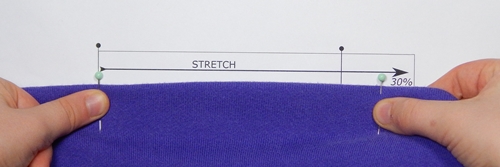
Sweatshirt Fleece - This is called fleece... but it's pretty obvious that this particular type does not have enough stretch to meet the 30% minimum. However, there are other varieties of Sweatshirt Fleece that might, or they may have enough stretch on the lengthwise grain instead (which you could use, as long as any print on the fabric is also oriented correctly), so this really comes down to doing a test before you buy.
Not many fabrics have the stretch percentage printed on the bolt, so knowing how to do a stretch test in-store will be very helpful. Some online fabric shops do print the amount of stretch in the fabric description, which can be very helpful. One of my favorite fabric shops, L'oiseau in Calgary, Alberta, includes the percentage of stretch in most of their listings, and their sweatshirt fleece ranges from as little as 10% to the needed 30%.
Having said that though, I do have one caution... there may be other things to consider if choosing to use a fabric that isn't specifically designed for a certain pattern. Thinner knits, such as cotton/lycra blends, will drape differently and be a more relaxed fit because they are less stable. With some knit fabrics you may have to use a stretch needles or a stretch stitch, or the edges may need to be finished which would make them a poor choice for certain techniques such as the wrapped fleece binding that I use in a few of my fleece patterns. If you aren't sure whether a fabric would be suitable for a pattern designed for fleece, a good place to ask questions would be in the designers facebook group, such as Pollywoggles Sew & Chat!
If you missed the post talking about the different types of fleece that are shown here, be sure to check that one out... it is called Sewing with Fleece... What is Fleece?
And be sure to download your own copy of the Stretch Guide.
DOWNLOAD
I hope you enjoyed this Series and are inspired to sew with this fabulous fabric called Fleece!


